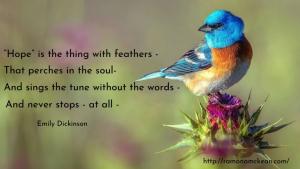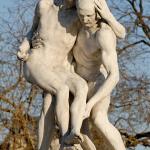Anyone who has ever stepped inside a Catholic church more than once for a mass that includes music has undoubtedly heard “On Eagle’s Wings.” I’m not Catholic, and “On Eagle’s Wings” is far from my favorite sacred song, but I do have a history with it.
 “On Eagle’s Wings” is a tune from the Catholic charismatic renewal movement of the 1970s and 80s. I became aware of such music from my wife Jeanne shortly after we got together in the late 80s. She was part of that renewal while I, as a born and raised evangelical Protestant, knew nothing of it. Most renewal music offends my classically trained musical ear, but it is easy to sing, has catchy tunes, and has turned out to be useful in a number of ways over the years.
“On Eagle’s Wings” is a tune from the Catholic charismatic renewal movement of the 1970s and 80s. I became aware of such music from my wife Jeanne shortly after we got together in the late 80s. She was part of that renewal while I, as a born and raised evangelical Protestant, knew nothing of it. Most renewal music offends my classically trained musical ear, but it is easy to sing, has catchy tunes, and has turned out to be useful in a number of ways over the years.
During the three years that we lived in Milwaukee while I completed my Ph.D. studies at Marquette University three and a half decades ago, I made some additional money beyond the pittance I earned as a teaching fellow by serving as the organist for Grace Presbyterian Church. I studied piano from age four, thought until my senior year in high school that I would be a concert pianist, realized that I would not be (I was good, but was not that good), then taught myself the organ in my mid-twenties after observing that I could make a bit of money by playing Sunday services for various congregations. Over time I have played in churches ranging from Catholic to Unitarian, Baptist to Episcopalian, frequently noting that I would attend any church that paid me to do so.
Grace Presbyterian was a small church, with no more than 100 or so in attendance each Sunday. In addition to playing the modest pipe organ, my duties included being responsible for their choir, which consisted of five people—one for each of the four parts with an extra soprano thrown in. And they were trying to sing pieces in four-part harmony, often pieces that would have been a challenge for choirs three or four times larger with well-trained voices.
Which they were not. Three of the five could read music reasonably well; one of the members who could read music was also tone-deaf. They sang with gusto, but the quality of their product was well below the energy they brought to it. So, I introduced them to some material that I thought, musically speaking, was more appropriate for their abilities. Jeanne had a singing career during her twenties before we met in our early thirties; one part of that career was being a minister of music and cantor in several Catholic churches in Brooklyn where she grew up. She introduced me to the music of the Saint Louis Jesuits, music whose deliberate simplicity in either unison or two parts is intended for congregational singing—or for choirs such as the one at Grace Presbyterian.
Anyone familiar with folk masses will recognize some of the tunes from the Saint Louis Jesuits: “Be Not Afraid,” “Here I Am, Lord,” “You Are Near,” “The Cry of the Poor,” and—of course—”On Eagle’s Wings.” Simple, straightforward, boring, and downright offensive to many. But they are singable, easily memorized, and can be handled by a congregation unused to participating in corporate song. Just perfect for my choir, in other words—and they loved the new tunes. Of course, I did not reveal to the choir they were learning Catholic worship songs until the new pieces became such a basic part of their repertoire that they were willing to look past their controversial source.
The text of “On Eagle’s Wings” is based on Psalm 91, which promises that “He will cover you with his feathers, and under his wings will you find refuge.” It’s an odd, but familiar, picture of the relationship of the divine to human beings. A dove at Jesus’ baptism, Celtic Christianity’s imagining the Holy Spirit as a wild goose, my family’s referring to the Holy Spirit as “Big Bird”–there’s something attractive about imagining the divine with avian characteristics. Emily Dickinson must have had this in mind when she memorably wrote that
 “Hope” is the thing with feathers –
“Hope” is the thing with feathers –
That perches in the soul –
And sings the tune without the words –
And never stops – at all –
Hope is a rare commodity these days, as was clear in a brief exchange I had with a woman on Facebook a couple of days ago. In response to a meme that quoted the late John Lewis saying “Do not get lost in a sea of despair . . . Be hopeful, be optimistic,” she wrote that
Personally, I find it almost impossible to feel hopeful. Every time there is another announcement of life becoming more difficult for many because Felon 47 is following the dictators handbook, my stomach knots in anger.
At which point I entered the conversation.
Hope is a choice. It cannot be dependent on things you don’t control.
But hope is an intangible thing, isn’t it? It may help prevent anxiety attacks in a person, but it has no muscle against the problem. I envy people who find comfort in hope. I honestly do. I don’t dare write what I do hope for. I don’t even say it out loud.o
Hope is not a comfort–it’s a motivator. And it isn’t blind (that would be wishful thinking). A person with hope envisions a better world in specific ways and works toward establishing it. Hope is a much better (and healthier) motivator than fear or anger.
I agree – mostly. If all people with hope actually worked toward their visions, we would be much better off. For many it’s just lip service. It is the people who act on their hopes and visions who, in the end, change the world for all of us. Thank G-d.
I appreciated the exchange, first because it was remarkably civil and fruitful for Facebook, secondly because it got me to put in writing some thoughts about hope that had been rumbling around for a while.
One of my favorite passages about hope comes from an unexpected place in the Jewish scriptures–the book of Lamentations. If you are not familiar with Lamentations, it’s probably just as well—it is undoubtedly the most depressing text in the Jewish scriptures, perhaps anywhere. I came face to face with it when on sabbatical several years ago. Of the many liturgical celebrations I participated in at St. John’s Abbey in Minnesota, the most striking is the Good Friday morning prayer service. At 7:00 in the morning, the service sets the tone for the day as a solitary monk chants the entire book of Lamentations, a litany of five poetic dirges over the destruction of Jerusalem.
Traditionally attributed to the prophet Jeremiah, the tone of the poems is bleak: God does not speak, the degree of suffering is presented as undeserved, and expectations of future redemption are minimal. In Psalm 129 the Psalmist writes “Plowmen have plowed my back and made their furrows long”—Lamentations is page after page of that sentiment. Except for a passage right in the middle of the book I had forgotten about, a place where for a moment Jeremiah comes up for air.
I will call this to mind, as my reason to hope:
The favors of the Lord are not exhausted, his mercies are not spent;
They are renewed each morning, so great is his faithfulness.
My portion is the Lord, therefore will I hope in him.
Good is the Lord to one who waits for him, to the soul that seeks him;
It is good to hope in silence for the saving help of the Lord.
There’s something divine about hope, about the conviction that there is more going on than the day-to-day drudgery, pain, and suffering that so often seem to define the human condition. But as I noted in the conversation on Facebook, hope is a motivator, not a comfort. What is the world you hope for? What are you doing now and what will you do in the future to bring that hoped-for world more sharply into focus and more likely to happen?












